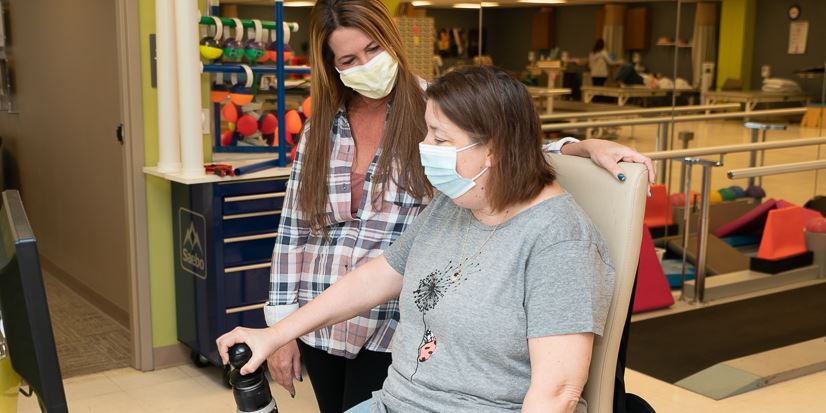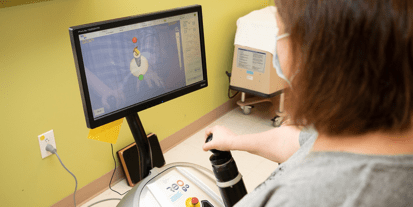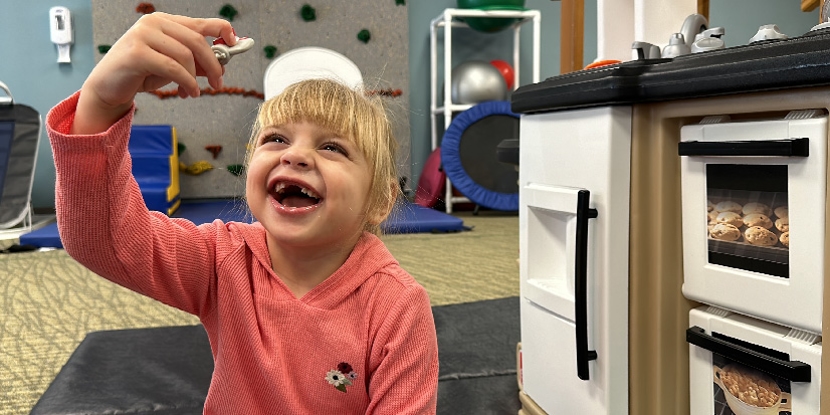Maribeth P.
- Author: Maribeth P.
- Date Submitted: Apr 22, 2021
- Category: Stroke


MARIBETH P.
In July of 2020, Maribeth underwent a colon resection. She awoke from surgery, unaware that an entire day had passed since she entered the operation room. As she became more and more alert though, she began to realize things weren’t quite right.
“I really don’t remember much from the first day. I didn’t even know I had been asleep that long.”
“They kept telling me something happened during surgery, and I was going to be ok - and I was like - OK?!?! (confused)”
“I wasn’t in any pain. I didn’t even realize anything was wrong until they asked me to do things like pick up my arm or move my leg. Then when I wanted to get out of bed to go to the bathroom and my leg wouldn’t move the way I wanted it to. That’s when it really hit me.”
During what was a routine surgery, the 53-year-old from Plains had some difficulties waking up from anesthesia. Doctors noticed a facial droop and it was discovered that Maribeth had suffered a stroke sometime during the procedure. After performing more diagnostic tests, it was discovered that one of Maribeth’s carotid arteries was 85 percent blocked.
A wake-up call: Carotid Artery Disease
Carotid arteries are the main blood vessels that carry blood and oxygen to the brain. If you have carotid artery disease, the arteries become narrow or blocked, usually because of atherosclerosis. Atherosclerosis is the buildup of plaque, which is made up of fat, cholesterol, calcium, and other substances found in the blood.
Carotid artery disease is a serious condition because it reduces the flow of oxygen to the brain. If the narrowing of the carotid arteries becomes severe enough that blood flow is blocked, it can cause a stroke. If a piece of plaque breaks off it can also block blood flow to the brain. This too can cause a stroke.
Much like coronary artery disease can block the vessels of your heart and cause a heart attack, carotid artery disease blocks the vessels leading to your brain and can cause a stroke.
Beginning Stroke Recovery
“After they found out I had a stroke, I was in the hospital for about 5 or 6 days total. After about 3 days, I was able to walk by myself. The droop in my face went away really quick too, but my arm was just dead weight. I was actually getting black and blue marks on it from bumping into things with it. They had to send me home in a sling. I just had no control over it.”
In Maribeth’s case, there was no need for emergency surgery to correct the blockage in her carotid artery. Once she regained some of her strength, she was discharged home to recover from her first surgery. She would return to the hospital about 2 weeks later to have a stent placed in her carotid artery.
Stenting and angioplasty are common types of procedures to improve the blood flow in an artery or vein. During the procedure, a thin flexible tube, or catheter, is put into an artery and then gently guided to the problem area of the artery. The catheter has a tiny, deflated balloon at the tip. When it reaches the narrowed portion of your artery, the balloon is inflated opening up the narrowed area. This is known as angioplasty. Once opened, a tiny mesh tube called a stent may be put into this area. Leaving the stent in place helps keep the artery from narrowing again.
Following the placement of her stent, Maribeth would receive therapy at her home for a few months before coming to Allied Services Wilkes-Barre Rehab Center in October.
Regaining Function following a Stroke

“When Maribeth arrived, she had some functional movement, but her arm was very weak. She had all the components she needed, but the weakness in her hand and arm, and the pain in her shoulder were limiting her,” noted occupational therapist Lori Ackerman, MHA, OTR/L.
“Maribeth’s stroke affected her dominant hand and when that happens, it greatly affects your activities of daily living. Things like getting dressed, brushing your hair or teeth, feeding yourself, and other fine motor skills are affected.”
“Many times, patients will begin to favor their non-dominant hand, but it’s important for patients to keep practicing and keep using the affected limb. With time, practice, and repetition - functional gains can be made.”
Due to the nature of the lingering deficits in her right arm, Maribeth is unable to return to work, but she continues to remain positive and is grateful for the support from her family, especially her daughters, Lauren and Julia.
“Maribeth is strong, dedicated, and determined to recover. There is not one day that she doesn’t give 100% for herself and her daughters,” noted Ackerman.
Stroke Awareness: Know Your Risks
Carotid artery disease often does not cause symptoms until the blockage or narrowing is severe. However, one warning sign may be a transient ischemic attack (TIA), also known as a "mini-stroke." A TIA is a stroke that lasts only a few minutes. Symptoms of a TIA are like other stroke symptoms but do not last as long. They happen suddenly and include numbness or weakness (especially on one side of the body), vision loss and/or blurry or double vision, vertigo or loss of balance and coordination, and slurred speech or difficulty understanding others.
You may have more than one TIA, and the recurrent signs and symptoms may be similar or different depending on which area of the brain is involved. Since TIA’s most often occur before a larger, more significant stroke, seeking medical attention is essential. Early identification of potentially treatable conditions may help you prevent a stroke.



